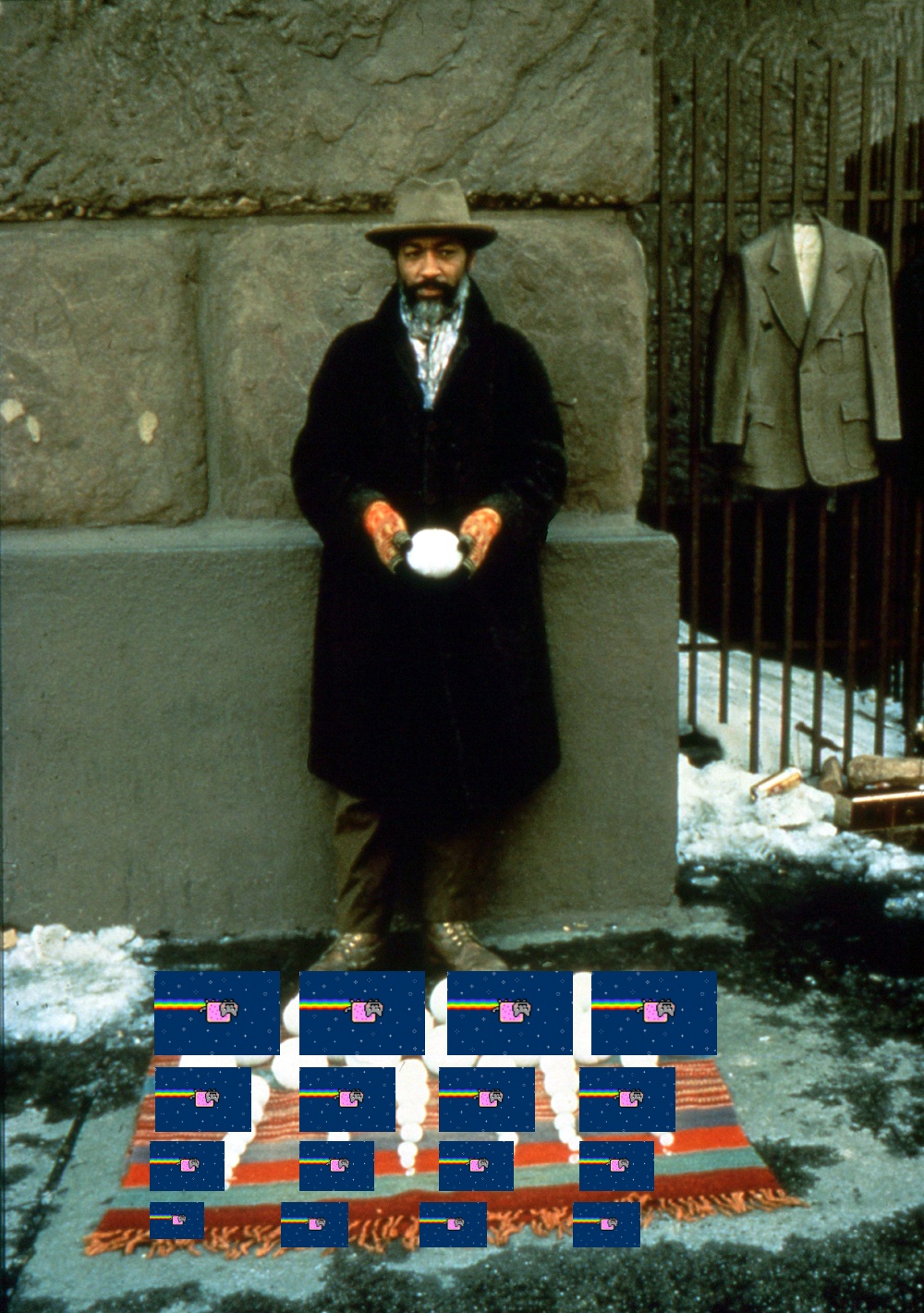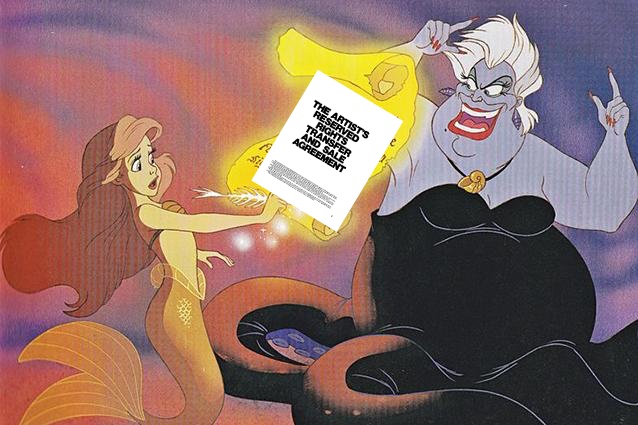The Dash column explores art and its social contexts. The dash separates and the dash joins, it pauses and it moves along. The dash is where the viewer comes to terms with what they’ve seen. Here, Joshua Caleb Weibley links the oddly material dematerialization of non-fungible tokens (NFTs) to that of conceptual art.

Illustration by Nick Kramer, 2021.
Proponents of non-fungible tokens (NFTs) unwittingly take up Douglas Huebler’s 1970 declaration that, “The world is full of objects, more or less interesting; I do not wish to add any more.” He preferred, “simply, to state the existence of things in terms of time and/or place,” which is a fair summary of an NFT: a unique, collectible string of code logged to the Ethereum blockchain that points to and certifies a particular edition of a digital file as authoritative. The wave of artists now scrambling to hawk crypto tokens share a certain faith in the immateriality of this new contract form, but without the market skepticism that drove early conceptualists. Watching a remastered Nyan Cat token sell for over half a million dollars at auction, it is hard not to hear Lucy Lippard lamenting that “art that can be shown inexpensively and unobtrusively in infinite locations at one time” suddenly pleads for the scarcity and commodity status it once struggled to shed.
Overwhelmingly, an NFT is not the work in itself, but artists have proposed inventive uses for the blockchain that engage with it at the level of its processes and poetics. The results often scan as rehashes of canonical conceptual gestures. Rhea Myers made many innovative early works using the Ethereum blockchain, including Art Is (2014/2017), a numbered list of statements logged to the chain that closely resembles Sol LeWitt’s Sentences on Conceptual Art (1969) or Richard Serra’s Verb List (1967–68) in form. The difference is that one can pay progressively-mounting fees to edit Myers’s dictums. Her list is framed less as a monolithic ontological exercise than as a social experiment presuming people will choose their words more carefully and think harder about what art is if they’re paying ever more to give their two cents. Billy Rennekamp’s Clovers (2019–ongoing), in which participants are rewarded for generating permutations of the game Othello, can similarly be encoded into NFTs and stored on-chain. Other artists have reasserted the public availability of their work, using NFTs as a rhetorical opportunity to consider the nature of value, as in Cassie McQuater’s moreToMe.txt (2021), a freely downloadable text file stating that, “This relationship is worth more to me than money.”
The conflation of an artwork with a contract or certificate of authenticity is as central to conceptualism’s legacy as is (supposed) dematerialization. Likewise, the most exciting proposition NFTs make is the potential for resale royalties—which is why it is surprising that, in the surfeit of breathless NFT coverage, the Artist’s Reserved Rights Transfer and Sale Agreement written in 1971 by formative conceptual art dealer Seth Siegelaub and lawyer Robert Projansky is rarely mentioned. In its time, the contract was novel in that it proposed a long-term financial solution to the precarity of working artists by guaranteeing them a percentage of secondary sales, among other provisions. The Siegelaub/Projansky contract has been widely disseminated and, much like the animated cat with the Pop-Tart body, heavily remixed. Alex Strada, for one, has added the stipulation that the contractually defined work be resold after a decade and the proceeds used to purchase another work by an “emerging female-identifying artist.” Her version of the contract is available to purchase as an artwork in its own right, presumably subject to itself. Lauren van Haaften-Schick has written recently about her own addition redistributing 15% of resale proceeds to a charity of the artist’s choosing. She also points to similar resale contracts by Nari Ward in 2019 and Cady Noland in 1992. The Siegelaub/Projansky document and these strategies to tweak it prefigure gestures by Sara Ludy and Nicolas Sassoon, who are both now selling NFTs through the galleries that represent them with analogue contracts for redistribution rights directing sale proceeds to their galleries’ staff.

Illustration by Nick Kramer, 2021.
The truth is that enforcing a contract has always meant lawyering up and/or collective bargaining. Until more substantive contractual language is in wider use and integrated with the tokens themselves, an NFT has no prayer in court. The terms of service drafted by each marketplace platform also vary, often superseding legal ownership and resale claims of both artist and collector. Paul Slocum of the stalwart digital art gallery And/Or asserts that, due to these terms, most NFTs prevent their associated works from being shown in a museum. The sly language of Mendi + Keith Obadike’s 2001 Blackness for Sale eBay auction comes to mind, with its promise of ownership for the winning bidder followed by warnings against using the quality on offer in any public capacity (“The Seller does not recommend that this Blackness be used by whites looking for a wild weekend.”) Frankly, even Siegelaub/Projansky’s Transfer Agreement is a tenuousmeasure, perhaps in part because it wasn’t widely adopted enough to become an industry standard. In 1987, a work by Hans Haacke, one of the few artists to consistently use the contract over the course of his career (and, like Siegelaub, a fellow Art Workers’ Coalition alum), came to auction. As the New York Times reported, during public viewing, the contract was displayed beside Haacke’s work on a pedestal as if it were itself a piece of conceptual art. This fetishization of the document was a fig leaf over its flimsy authority. Lacking settled case law, the fulfillment of its terms following that sale should be understood less as firmly binding legal precedent than as an amused acquiescence to the artist’s whims by the auction house, seller, and buyer—collectors of Haacke’s work who bought into the artist’s political attitudes as much as his material forms.
NFTs’ legal issues don’t end there. Concerned with conflicting accounts of carbon emissions associated with the energy-intensive proof of work computations needed to add blocks to the Ethereum blockchain, Rosa Menkman took a principled stand against them, only to find that others had minted NFTs of her images, once even under her name. This recalls the thousands of blank sheets of paper Salvador Dalí pre-signed in the early seventies in advance of sketches and lithographs, which vastly increased the efficiency of his production but also resulted in an explosion of forgeries. Menkman describes an hour-long phone conversation with one of the founders of the platform where her images appeared; he offered little help. However, when an artist known as Robness was found to be minting images copied from the website of Home Depot, the administrators of the collectables marketplace SuperRare swiftly delisted them, likely before Home Depot noticed a problem. It is worrying to see platforms either shirk the duties of moderation when it comes to the work of an individual artist, yet preemptively police a corporation’s intellectual property.

Illustration by Nick Kramer, 2021.
What Huebler’s statement in 1970 conveniently ignored are hoards of framed photographs and documents he duly added to the world, instantly giving lie to the dematerialization haunting conceptual art. As for NFTs, no one agrees about what (or whether) reparative action can ameliorate the severe environmental costs of crypto mining operations—which by some accounts use as much energy as Argentina—but this consideration should not be waved away. While The Carbon Drop, a massive NFT fundraising initiative hosted by Nifty Gateway, paid for five hundred tons of carbon offsets, it expended one ton of carbon in the process, which may subvert its benefits if critics of offsets are to be believed. Given these energy expenditures (not to mention the ongoing pileup of very material electronic waste), it’s laughable to imagine someone calling NFTs immaterial. Yet Mitchell F. Chan does just that in a lengthy editorial for SuperRare. He frames Yves Klein’s contractual work Zone of Immaterial Pictorial Sensibility (1959) as a token “stored in-chain,” before introducing his own NFT remake. In Klein’s original, the buyer paid in gold for a receipt certifying ownership of empty space. If desired, the payment could then be used in a ritual act during which the receipt would be burned and half the gold thrown into the Seine. Of course, collectors were paying for more than just empty space. They were paying for the thrill of participating in the performance of reallocating their money, half to Klein and half to pollute the Seine. Undoubtedly, today’s NFT hounds are throwing their millions somewhere similar, and with a larger footprint. Chan also discusses Klein’s pre-Zone act of emptying the Iris Clert Gallery in 1958, but a better lodestar for NFTs happened there two years later when Arman, a childhood friend of Klein’s, filled the same gallery with so much garbage that viewers couldn’t even enter. Klein loved it. Perhaps the most enduring statement about the physical presence of art online was posted to Twitter by digital art conservator and archivist Ben Fino-Radin in 2013: “Every time you reinforce the myth of immateriality, somewhere, a hard drive stops spinning.” X

Joshua Caleb Weibley is an artist and writer living in Brooklyn. He makes memento mori for techno-optimism.